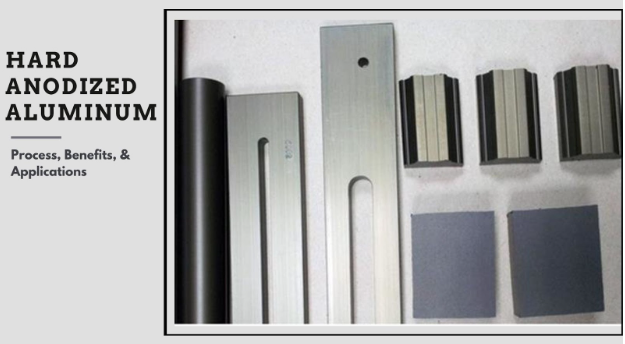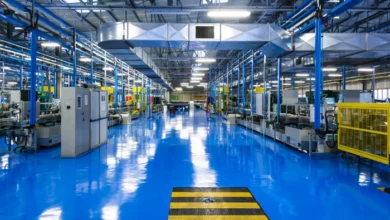Hard Anodized Aluminum: Process, Benefits, &

Have ever noticed the smooth and lightweight cooking pans with dark grey or black colors in your kitchen? Well, they might be hard anodized aluminum. However, the use of hard anodizing is not limited to cookware and kitchen utensils, it has a significant range, including aircraft parts, semiconductors, and medical applications.
Although hard anodizing follows the same principle as ordinary anodization, electrochemical parameters like electrolyte, voltage, and bath temperatures cause distinct results. The main differences are in surface hardness, oxide thickness, and appearance.
Furthermore, we will elaborate on the hard anodizing process, benefits, applications, etc.
What is Hard Anodized Aluminum?
Hard anodized aluminum cookware
Hard anodized aluminum refers to aluminum parts or materials with an oxide layer on the surface developed by the electrochemical process. The thickness of this layer ranges from 0.0125 to 0.00725 mm ( 0.0005 to 0.0030 inches).
The coat of hard anodizing provides excellent corrosion resistance, improves surface hardness, and produces matte or smooth surface texture. Additionally, the porous nature allows the absorption of dyes more effectively.
One of the popular application examples is hard anodized aluminum cookware, which enhances the surface hardness and maintains hygiene. Architecture, Structure, Automotive, and other indsurries also use this finishing method.
The Process of Hard Anodize Aluminum
Hard aluminum anodizing uses electrochemical reactions to form aluminum oxide on the surface of the part. Cleaned parts are immersed in the electrolysis tank of sulphuric acid with the necessary arrangement and electric supply.
Hard anodizing process
The following are the key steps of hard anodizing of aluminum;
Step 1: Surface Cleaning
First, the surface of the substrate aluminum parts is thoroughly cleaned to eliminate rust, dirt, oil, or other contaminations. Acidic or alkaline solutions are used for this, followed by neutralization with pure water.
Step 2: Etching and Desmutting
A chemical etching process eliminates oxides and makes the surface uniform. It also helps to increase the adhesion of the anodized layer. Consequently, the desmutting treatment removes any residual smut or alloying elements from the surface.
Step 3: Anodizing Setup
Typically sulphuric acid electrolyte (10% concentration by weight) is used as the electrolyte, whereas the parts to be anodized are connected as anode. Instead of connecting each substrate with current, arack is used that can hold(or hang) multiple aluminum parts. Next, Carbon, nickel, or stainless steel are used as a cathode. The temperature of the electrolytic bath is maintained below 10 degrees.
Step 4: Hard Anodizing Process
Once current is introduced to the circuit, oxygen ions from the sulphuric acid solution go to the anode(aluminum parts) and react with aluminum to form oxide. The growth of this chemically bonded oxide layer is in both directions from the surface.
The thickness of hard anodized aluminum heavily depends on the duration of the process.
Step 5: Sealing and Dyeing
The hard anodized surface is less porous than ordinary, but suitable dyes can be applied for aesthetic requirements. For instance, black anodized aluminum sheets are made by applying black dyes on anodized sheets.
For sealing, anodized parts are immersed in the deionized hot water or other sealing solution. It closes the pores on the anodized coating.
Is Hard Anodized Finish Similar to Black Anodized Aluminum?
Black anodized parts
They are not exactly similar to each other, black anodized aluminum involves the use of black dyes in the anodizing solutions, so the parts absorb the dyes along with oxide layer development. It is not necessary to have hard coat anodizing, even ordinary anodizing with chromic acid can also make black anodized parts.
“Black anodizing is all about achieving sleek and permanent black color on the parts by mixing suitable black dyes in an electrolyte solution.”
Black anodizing aims to achieve a specific aesthetic appearance rather than focusing on the thickness it is often utilized in products where visual appeal is important. Common application areas are electronics, architectural elements, and decorative items.
Benefits of Hard Coat Anodizing on Aluminum Parts
From improving the physical and mechanical properties to aesthetic quality, hard anodizing provides many benefits to aluminum parts.
Here are the key benefits;
- Precision Coating: The uniform and double-growth of anodizing results in a precise finish, even for complex features and holes. It means great control of thickness.
- Electrical and Thermal Properties: The coating provides insulation to electricity, but the underlying aluminum does not lose any properties. Same with the heat conduction characteristics.
- Improved Hardness: It improves the hardness of aluminum parts up to 500 HV. This also enhances the wear and abrasion resistance.
- Corrosion Resistance: The thicker coating of anodized aluminum makes the parts oxidation-resistant, protecting them from corrosion and material degradation.
Applications of Hard Anodized Aluminum
Hard anodized aluminum parts
Whether they are hard anodized CNC machined parts, those made with the forming of black anodized aluminum sheets, or extruded items, this type of surface finishing technique improves strength, hardness, and corrosion resistance.
One of the key applications is hard anodized aluminum cookware. The anodizing process transforms the cookware surfaces into durable, corrosion-resistant, non-reactive, and non-stick layers.
In automotive, hard anodizing is used for pistons, cylinder heads, control arms, strut mounts, trims, etc. Some aircraft’s aluminum components are also finished with this method like support structures, piping systems, fuse glass, etc.
In the medical industry, surgical instruments, diagnostic equipment components, orthopedic items, and dental tools utilize a hard anodizing finish.




